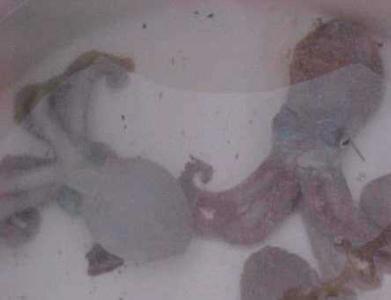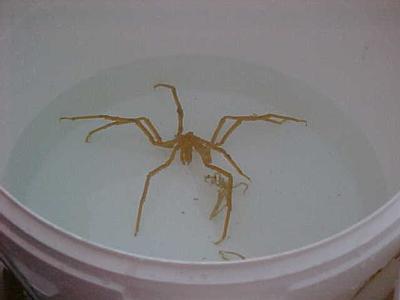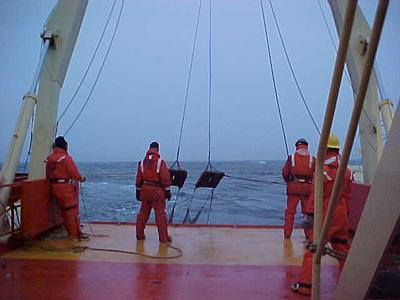10 March, 2000
We are still gathering samples and data at Station C. It is about
three degrees Celsius today with the water temperature between 1 and
2 degrees Celsius. The wind is still blowing about 40 knots with a
light freezing rain and the swells are 5-8 feet. We are still
having to repeat our box core sampling and multicore sampling because
many times the rough seas keep the gear from landing correctly at the
bottom and getting a good core of mud. It is between 500 and 550
meters deep here and takes several minutes for the gear to reach the
bottom as the cable lets it down. With the waves it is very
difficult to get the gear to fall vertically straight down and land
upright.
This afternoon we used an otter trawl to collect sea animals (mostly
macroinvertibrates and a few fish). An otter trawl is a net towed
behind the ship the are weights along the bottom edge of the net to
hold that down and floats along the top edge of the net to hold it up
so that the net can be towed vertically through the water. There are
heavy wooden doors attached to each side of the net to hold the net
open from side to side. As the net is towed through the water the
animals swim or are scooped into the wide opening. The back part of
the net is very narrow so that the animals cannot swim or move back
out. When the net is pulled back on board the back end of the net is
untied ant the animals are placed in trays of water.
Our otter trawl was very successful with lots of interesting
animals:sponges, worms, sea anemones, crinoids, octopus, baby sea
urchins, sea stars and brittle stars, gastropods (snails), clams and
a few fish (even a tiny ray).
We spent a good part of the evening sorting our catch and putting
some things in the aquarium and preparing some of the dead organisms
for tests such as DNA analysis back at the university labs.

Octopus from the otter trawl

An antarctic sea spider; they grow really big here

Deploying the otter trawl off the fantail of the ship
Contact the TEA in the field at
.
If you cannot connect through your browser, copy the
TEA's e-mail address in the "To:" line of
your favorite e-mail package.
|
